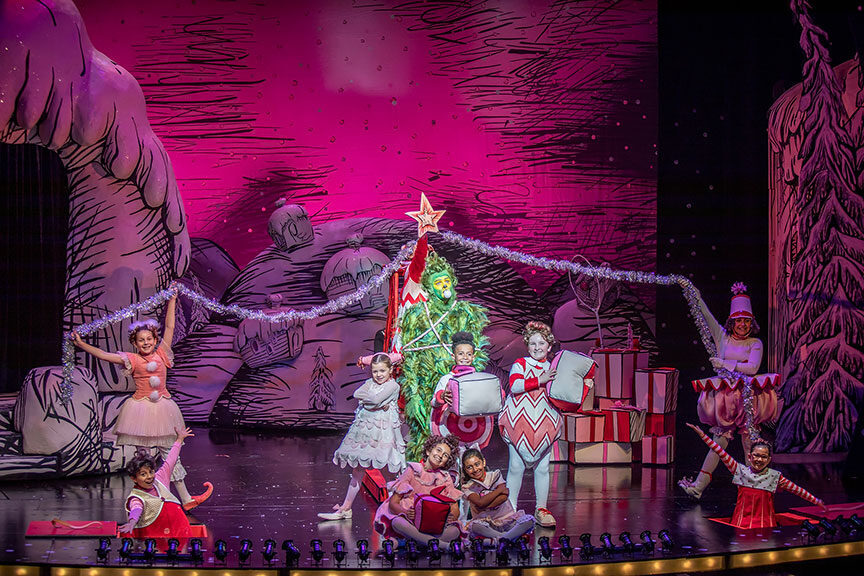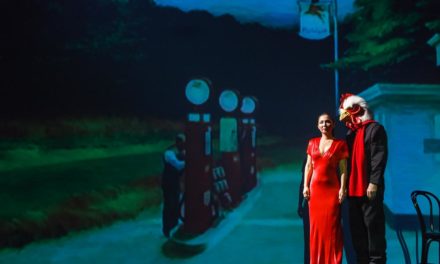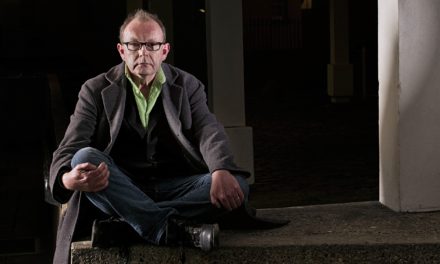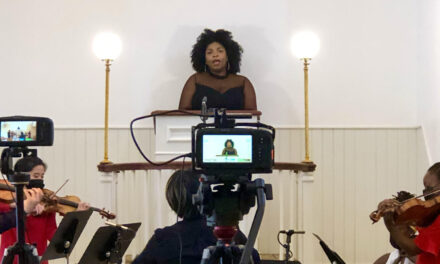For the past twenty-three years, The Old Globe’s production of Dr. Seuss’ How The Grinch Stole Christmas!: The Musical has become an established and cherished holiday tradition in the San Diego community. Since 1998, the musical about the ‘green ol’ grump’ who terrorizes the Christmas festivities of the happy “Whos down in Whoville” has been performed on The Old Globe stage every holiday season. The show eventually made its Broadway debut in 2006, and spawned road companies throughout the United States that included sit-down productions in Los Angeles and New York’s Madison Square Garden. In 2020, the show intends to keep the Christmas spirit alive in San Diego . . . just a little differently. This year, due to the pandemic, Dr. Seuss’ How The Grinch Stole Christmas!: The Musical is being presented as a radio play through the KPBS radio station.
While audiences young and old will still be able to experience Dr. Seuss’s story (adapted by Timothy Mason with a phenomenal score by Mel Marvin) they will not be able to experience one of the key aspects that makes the stage adaption of The Grinch sparkle – the visual world of the show. The Grinch has costumes designed by Robert Morgan and lighting designed by Pat Collins. Their creative designs help bring the pages of Dr. Seuss’ story to life for audiences. I recently had the opportunity to talk with two of the people responsible for implementing Morgan’s and Collins’ original designs every year – Associate Lighting Designer Chris Rynne, and Associate Costume Designer Shelly Williams. We discussed their collaboration with the original designers, how they keep The Grinch looking fresh for audiences year after year, and their fond memories of working on the piece throughout the years. First, I begin with Associate Lighting Designer Chris Rynne.
Colden Lamb: How did you acquire the job for The Grinch?
Chris Rynne: In 1998, Jack O’Brien, the artistic director of The Old Globe at that time, and Audrey Geisel, Dr. Seuss’s (Ted Gisel’s) wife and patron of the theatre, came up with the idea to present The Grinch as a stage musical in San Diego. Pat Collins came onto the project as the lighting designer, along with her associate, D.M. Wood. That same year, I was hired as the Resident Assistant Lighting Designer for The Old Globe, which meant that I was going to be assisting on all the shows being staged at The Globe that year, including The Grinch. It was a case of being at the right place at the right time. It was really special that I got to work on The Grinch from the very beginning because I’ve had a chance to participate in the evolution of the show.
CL: What have you been doing lighting-wise with the show since 1998?
CR: After the successful run in 1998, The Old Globe decided to revive the production each holiday season and since then, it has been my job to re-implement Collins’ lighting for The Grinch each year. As changes in blocking occur, portions of the script change, and technology evolves over the years, I’ve been responsible for updating the design while maintaining the spirit of what was originally produced. Through my work with, and for Pat Collins on this piece, I ended up being a part of the design team as the assistant designer for the Los Angeles production of The Grinch – which had a different style that was bigger, louder and implemented more flashy elements.
CL: What was your working relationship like with Pat Collins?
CR: It was mainly through our time together on The Grinch, as well as a couple of other productions at the Old Globe over the years, that we got to know each other well. As a designer, Pat is great because she constantly looks for ways to support storytelling moments throughout a piece and continues to finesse and refine her design through the rehearsal process – she’s a true sculptor of light. Over the first couple of years we worked together, I earned her trust to the point where Pat left me in charge of taking care of The Old Globe’s production of The Grinch and encouraged me to contribute my own design ideas in order to keep the show fresh and relevant. I consider Pat one of my mentors – every time I worked with her she would provide great insights. She was also the main impetus behind me getting my designer union card. Pat Collins is just an amazing person and a force to be reckoned with.
CL: Has anything changed lighting-wise in the past twenty-three years?
CR: The show that was presented in 1998 is very different from what it is now. As the technology used by the entertainment industry has advanced, there have been many changes implemented over the years to help advance the storytelling visuals with lighting equipment. A couple of significant areas where we’ve been able to implement such advancements on the lighting side include control, projection, and color wash lighting. The computer-based lighting console we started the show which in 1998 was top-notch for its time, but as computer technology evolved, and we could see the potential for newer generation consoles to accommodate effects and layers in the lighting we wanted to accomplish in the show, the controller was replaced just a couple of years in. The show is now on its third-generation of the controller and there are lots of sophisticated tricks we’ve been able to program into the show that weren’t possible twenty-three years ago. With regards to advances in projection, we used to use several lighting fixtures, slide projectors, and cutout patterns of dots to make it snow in Whoville. The effect, while cute, was quite limited. Now we have a state of the art, large-scale video projector that allows us to achieve an effect of snow billowing down that is dynamic and much more realistic. With the emergence of color-changing LED lights, I can now get millions of lush colors and subtle shades that I was never able to get with our original stage lights – such as deep indigo washing over the Hills of Whoville late at night, and a chilly seafoam hue for the icy peak of Mount Crumpit. An interesting pair of lights we changed to LED in recent years make up the core and the corona of the sun in the sky, located in the center of the winter backdrop. With the change to the new lights, I am able to color the sun to match the mood of the scene – such as when The Grinch arrives in Whoville, the sun turns a nasty “Green Eggs and Ham” green, something we were never able to do before. I can also change the color of the sun’s core to a silvery blue and fade out the corona so now we have a moon that can be used in nighttime scenes.
Over the years I’ve added small lighting gags into the show – small jokes and such – but the lighting is still helping the story along, honoring the intent and the history of the piece.
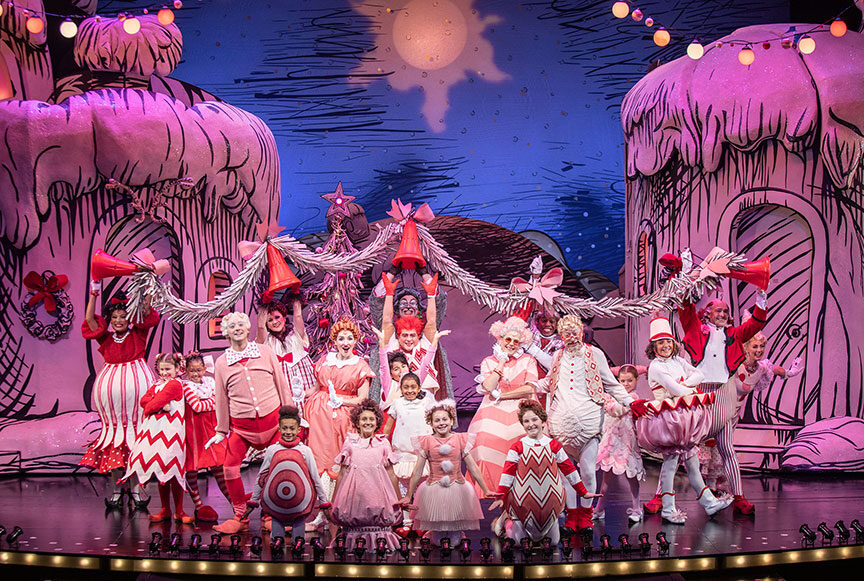
The cast of Dr. Seuss’s How the Grinch Stole Christmas!, book and lyrics by Timothy Mason, music by Mel Marvin, original production conceived and directed by Jack O’Brien, original choreography by John DeLuca, and directed by James Vásquez, running November 10 – December 29, 2019, at The Old Globe. Photo by Jim Cox.
CL: Do you enjoy revisiting the show each year? Any Grinch memories you would like to share?
CR: I do indeed enjoy revisiting the show. I find Grinch songs sneaking into my head in the middle of the year. I have worked on many versions of the show, and there’s something nice about the small scale of The Old Globe’s production. I felt the New York-based production, with it’s busier and flashier flair, was too comic-book-esque compared to the sweet children’s book feel we perform here in San Diego.
Twenty-three years ago, before The Grinch became an annual holiday tradition, November and December was a largely quiet time at The Globe, with lots of the staff taking time off for holiday vacations. Now, it’s the complete opposite and The Globe is bustling with performances and show-related events! I also used The Grinch’s original lighting plot as a computer drafting assignment with my students at UCSD last year. It’s a cool piece of history and it was fun to talk them through the evolution of the lighting tools we’d use on the show over the years.
CL: With NBC presenting their live TV adaptation of the musical, the pandemic, and the free radio production of The Grinch, do you think audiences will be more or less eager to come back to see The Old Globe production when it hopefully returns?
CR: I think they’ll be more eager because there is a real thirst for human connection. I recently discovered this when I finished lighting San Diego Opera’s drive-thru production of La Boheme in October. Hundreds of spectators congregated over multiple nights in a parking lot to watch live opera from their cars. The number of people who came to La Boheme really showed that people really want to gather and celebrate live arts. Obviously, there is media content out there that is cheaper for one to watch but watching a televised version or a recording of a play is not the same as watching live theater in a gathered experience. When you have that gathering, that’s where the magic of theater can really be felt. The theatre is at its best when it is in person, especially when you have a splendid congregation of storytellers entertaining the audience.
I now go to Costume designer, Shelly Williams.
Colden Lamb: How did you acquire the job for The Grinch?
Shelly Williams: I began as an Assistant Costume Designer in 2000, the third time the show had been reproduced at The Old Globe. After working on the show for several years, I became the Associate Costume Designer, which was an extremely kind acknowledgment of all the work I had done up until that point. Every year when we reproduce the show, my job is to make sure the costumes look as they did when Robert Morgan first designed them back in 1998.
CL: What was the original design concept for the costumes?
SW: Originally, the creative team wanted to keep the design very true to Dr. Seuss’ book – as if we ripped the pages from the book and threw them onstage. In our library here at the Old Globe’s costume shop, we have a couple of copies of the original book. One of them has pencil marks and notations that Robert Morgan made at the beginning of his process, in particular, the page where the Whos of Whoville are on this big sun arch singing. Robert, and the rest of the creative team, were very careful in taking inspiration from the book and stayed true to the book’s strict color pallet of red, pink, white, grey, and black – with an exception for the Grinch who is green.
CL: How do you implement Robert Morgan’s designs each year?
SW: When I arrived in 2000, The Grinch had already been well documented through our Costume Bible – a gigantic compilation of paperwork, information, and fabric swatches used to implement every costume in the show. A typical show will have one costume bible, but due to the fact The Grinch has been running for many years, and has had different incarnations throughout the years, there are several costume bibles. Because I’ve done The Grinch for a multitude of years, a lot of what is in the bibles is already locked in my brain, which allows me to get certain tasks, such as costume fittings or getting supplies done more efficiently.
CL: Did any of the costumes change over the years, in particular after the show opened in New York in 2006?
SW: Over twenty years there have been advancements in materials and products, and things have undergone some change, especially with two of our leads, Grinch and Young Max. Before the New York production in 2006, The Grinch was in a pod costume similar to what the Whoville ensemble wears in the show. The Grinch’s costume is now two separate bodysuits, one is padded and the other one has the hair attached which is able to give the actor playing The Grinch to have more body articulation and better ease of movement for the choreography.
With Young Max, the fabric that we used for his fur changed, as well as the sweater he wore. Over the years there have been changes in how things are built and engineered. Halfway through the show, Max ends up with a big horn on his head. The original horn was heavy and it connected to the actor’s hair, causing it to be a little problematic, so it was re-designed. It is now made of a lighter material and different mechanics hold it on the head more comfortably.
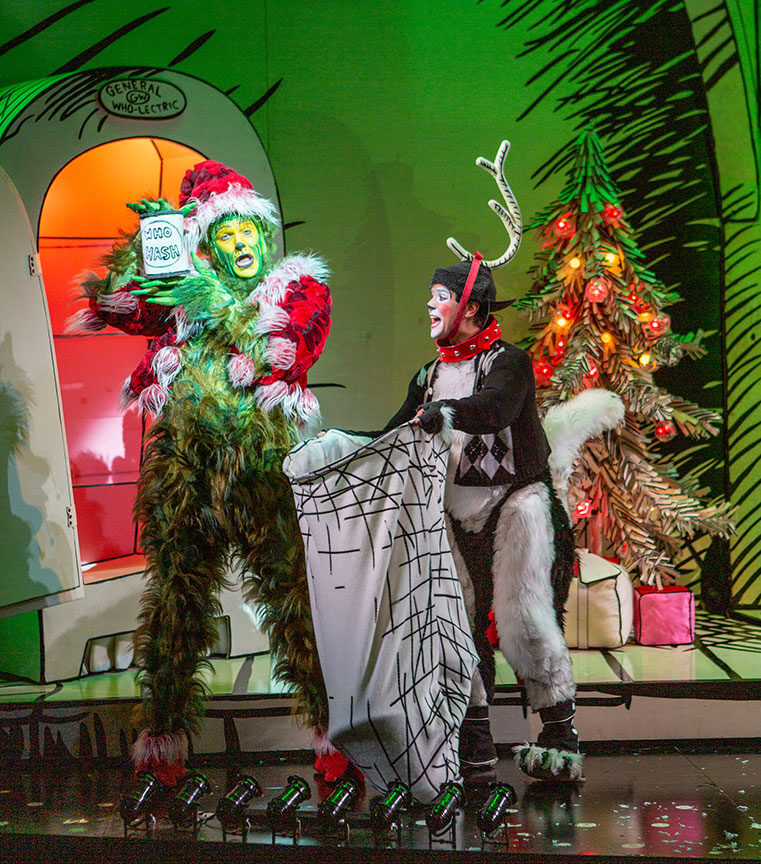
Edward Watts as The Grinch and Tommy Martinez as Young Max. Dr. Seuss’s How the Grinch Stole Christmas!, book and lyrics by Timothy Mason, music by Mel Marvin, original production conceived and directed by Jack O’Brien, original choreography by John DeLuca, and directed by James Vásquez, running November 10 – December 29, 2019 at The Old Globe. Photo by Jim Cox.
CL: One of the best costume elements in The Grinch are the Who’s wacky shoe designs. How are the shoes created each year for the show?
SW: All the shoes that you see in The Grinch are made in our costume shop. A majority of them are dance shoes that our craft shop molds with little bumps or extra curves and covers with leather.
It’s our priority that the shoes accommodate the actors. With The Grinch, for example, we use sneakers for the base in order to help him through the more active parts of the show. Another example happened one year when an actress playing Grandma Who, due to back issues, couldn’t wear the high heels the character usually wears. The costume team found loafers for her, then I came up with some ideas about how we could decorate those shoes to make them look more Dr. Seuss-ian. We then sent those ideas to Robert Morgan, who approved the newly designed shoes, and we implemented them into the show.
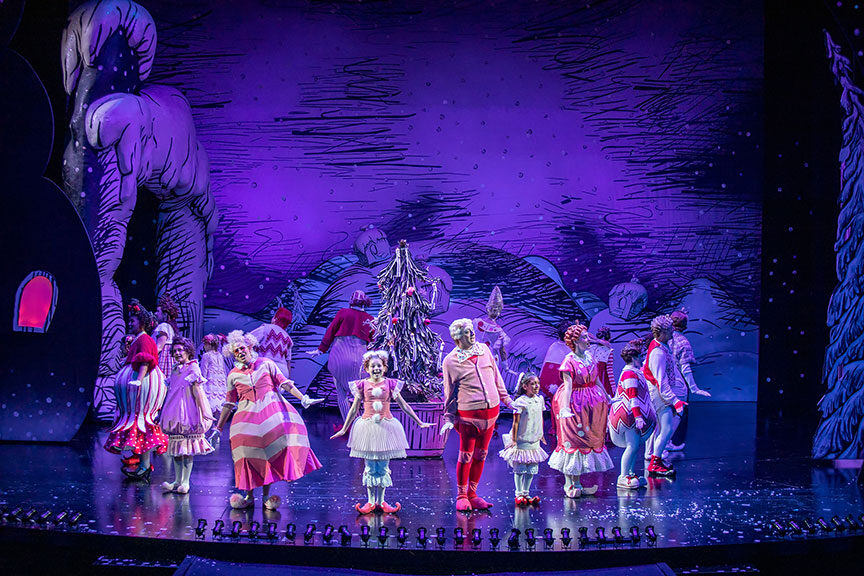
The cast of Dr. Seuss’s How the Grinch Stole Christmas!, book and lyrics by Timothy Mason, music by Mel Marvin, original production conceived and directed by Jack O’Brien, original choreography by John DeLuca, and directed by James Vásquez, running November 10 – December 29, 2019, at The Old Globe. Photo by Jim Cox.
CL: Do you enjoy revisiting the show each year? Any Grinch memories you would like to share?
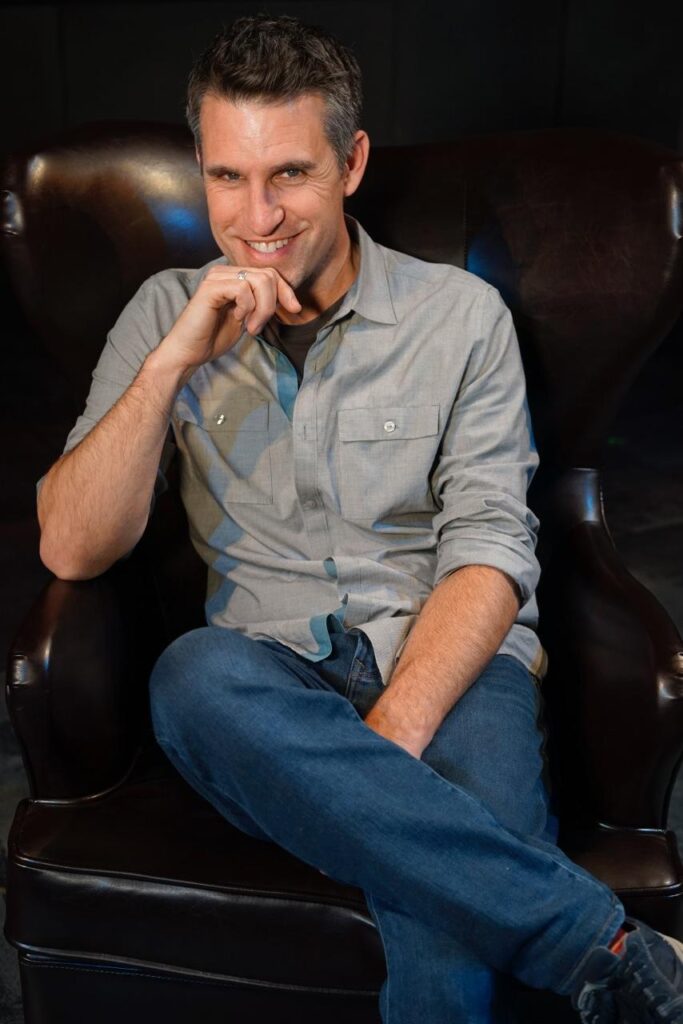
Chris Rynne, courtesy of Cygnet Theatre
SW: I love doing The Grinch every year. It’s so much fun. The entire cast and creative team, especially the kids, just love Christmas and really love being a part of the show. We have had actors move around to different parts in the Whoville ensemble and nobody ever gripes about it – the actors just love being in the show and they are happy to do it, which I think is kind of rare. The same goes for the kids’ tracks as well. When a child playing Cindy Lou Who grows too big to play the part, they will be one of the other Who sisters, which is a smaller role. From what I’ve seen, the former Cindy Lou Whos don’t seem to care – they just want to be in Whoville.
Every year, the cast and creative team do a Secret Santa gift exchange the week before Christmas and it’s always fun to see the cast and crew so excited. It just kind of permeates everything.
CL: With NBC presenting their live TV adaptation of the musical, the pandemic, and the free radio production of The Grinch, do you think audiences will be more or less eager to come back and see The Old Globe production when it hopefully returns?
SW: I think what I said about how The Grinch makes me feel year after year, and how I’m excited to come back to it holds true for San Diegans. For a lot of families, it’s a tradition. I have friends who see it every year. I don’t think that will change. The Grinch also hosts sensory-friendly performances that give families a safe theater environment where they can take kids who are on the spectrum – this has proven to be a great success. There have been other incarnations of The Grinch, such as the Chuck Jones animated special, and the Jim Carrey film, yet people still come back to our production at The Old Globe. I’m glad we’ll be able to hear it over the radio but there is something magical about seeing all the design elements blend beautifully together in person. When you see it on stage in person with the costumes, automated scenery, lighting, sound effects, and music, it really feels like Dr. Seuss’ book is literally coming to life in front of your eyes on the Globe’s stage. The Grinch is a beloved musical that San Diegans love and I don’t think that’s going to change just because Matthew Morrison is on TV.
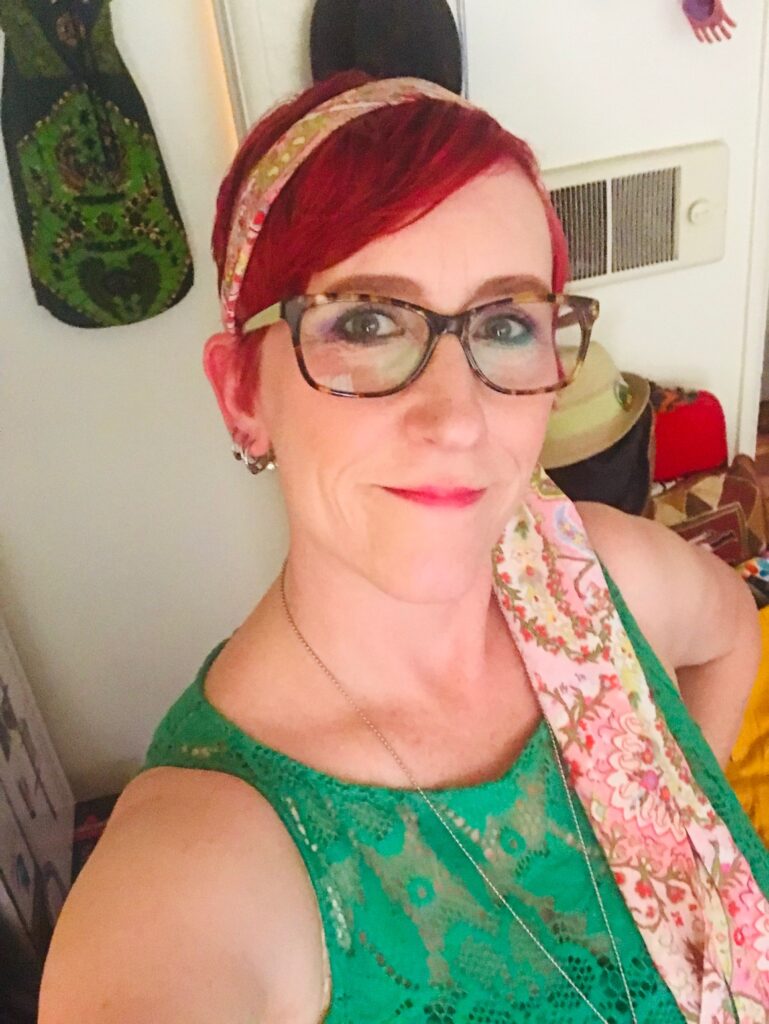
Shelly Williams, courtesy of Cygnet Theatre
Chris Rynne is a lighting and scenery designer of theatre, opera, museum exhibitions, and architectural features. His theatrical design work has been seen in productions around the country including The Old Globe, San Diego Rep, San Diego Opera, Cygnet Theatre, Pasadena Playhouse, Madison Opera, Houston Grand Opera, Michigan Opera Theatre, Hartford Stage, Geffen Playhouse, Laguna Playhouse, Berkeley Rep and Off-Broadway. He has been responsible for lighting a number of independent touring theatrical productions that have played around the United States as well as in London, Paris, and Tel Aviv. In addition to his lighting design work, Chris also specifies theatrical, entertainment, and architectural control systems for theaters, houses of worship, hospitality, theme parks, schools, museums, and architainment features. He is a member of USA829.
Shelly Williams has worked at the Old Globe as an Assistant Costume Designer/Shopper for 20 years. At the Globe, she designed the costumes for the Globe for All production of Measure for Measure. On the Sheryl and Harvey White stage she has designed the costumes for; Alive and Well, and Striking 12. She also works as a freelance Costume Designer. Her work has been seen at The San Diego Rep, Cygnet Theatre, MOXIE Theatre, North Coast Repertory Theatre, and Moonlight at the Avo. She received a BA in Costume and Make-up Design from Cal. State Fullerton and an MFA in Costume Design from SDSU.
Colden Lamb is a Southern Californian based actor. He is also a graduate of San Diego State University. coldenlamb.com
This post was written by the author in their personal capacity.The opinions expressed in this article are the author’s own and do not reflect the view of The Theatre Times, their staff or collaborators.
This post was written by Colden Lamb.
The views expressed here belong to the author and do not necessarily reflect our views and opinions.

